If it hadn’t been for the smash 1977 film “Star Wars,” Jennifer Sinsel might never have gone into teaching science and therefore could never have been chosen as the Air Force Association’s National Teacher of the Year for 2007.
“The first time I ever got interested in spaceflight,” Sinsel said, “was when I was a kid and I went over to my uncle’s house. My brother and I watched a video of ‘Star Wars.’ Those movies had begun to come out and we watched every one of them almost daily. I could have recited all of the dialogue. … I was fascinated by spaceflight.”
Sinsel was teaching fifth grade at Wichita Collegiate School, a private school in Wichita, Kan., when she was selected as AFA’s 22nd recipient of the Christa McAuliffe Memorial Award for Teachers. The honor is named for teacher-astronaut Christa McAuliffe, who perished in the January 1986 Challenger disaster. The award recognizes a public, private, or parochial school teacher in grades K-12 who promotes aerospace technology though innovative curriculum.
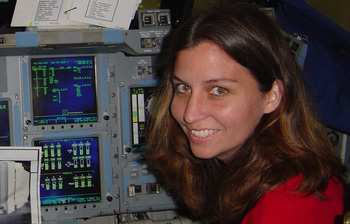 |
Jennifer Sinsel was a finalist in NASA’s educator-astronaut program in 2003. |
Sinsel received the honor and a $5,000 cash award during the AFA Air & Space Conference and Technology Exposition in Washington, D.C., in September 2007.
In high school, Sinsel was inspired by two memorable teachers. In biology class, she was taught by the North Dakota biology science teacher of the year, and her physics teacher was one of the finalists for the teacher in space program during the period when McAuliffe was involved.
After college, Sinsel worked at summer camp and loved working with kids, so she combined those two interests and became a science teacher.
After earning both a bachelor of science degree and a master of science degree from the University of North Dakota, Sinsel began teaching in public schools in Minnesota. Later, she moved to Wichita and started working at Wichita Collegiate. Wichita Collegiate School is a private college preparatory day school founded in 1963, and currently enrolls 966 children from preschool through 12th grade.
It was for her work at that school that she won the Teacher of the Year award, but in the fall of 2007 she began teaching a class for gifted children in the Wichita public school system.
“I continue to use the same approach as I did in the private school,” Sinsel said, “a lot of higher-level-thinking kinds of activities, a lot of problem solving where [the students] are forced to take knowledge and apply it,” with considerable analysis and evaluation.
“I’m teaching all levels of elementary now but only with gifted students,” she continued. “If I stay in this position, I will have some of these kids for five or six years.”
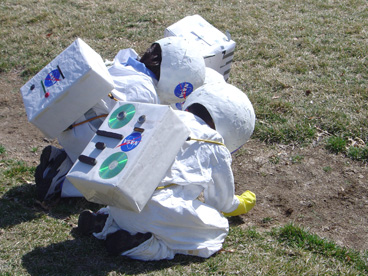 |
Two fifth-graders at Wichita Collegiate School collect mineral specimens on “Mars.” |
Innovative Techniques
Sinsel often uses an approach that combines subjects. “One of the middle school philosophies is to create interdisciplinary units so kids can see the connection between different subject areas” so topics are not just viewed as discrete matters, she said.
Prime examples are a recent space shuttle simulation and a Mars simulation.
Sinsel partnered with an English teacher and gave each student a position as an astronaut or a mission controller. The students performed various duties related to their positions and collaborated to make the mission a success. The students determined the mission.
One of the simulations was a trip to Mars; another dealt with attaching a solar panel to the space station. Sinsel took positions that NASA actually uses, such as flight director and flight dynamics officer, and created assignments for the students based on the specifics of their chosen mission.
The students took those assignments and completed them, as best they could. For example, the science team came up with experiments to do during the mission. Those named public affairs people developed a PowerPoint presentation and shared the mission with the audience. Sinsel said she and the English teacher “worked very hard” to combine different relevant skills.
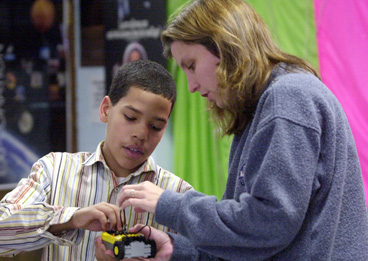 |
Fifth-grader Marcus Phox consults with Sinsel on a robotics project. |
Sinsel has earned numerous other awards for her teaching. In 2002, she was named Kansas Aerospace Educator of the Year. In 2003, she received an educator achievement award from the American Institute of Aeronautics and Astronautics, and in 2006 she was picked as the nation’s best middle school science teacher by the National Middle Level Science Teachers Association.
Then, in early 2007, she was selected as the Kansas recipient of the Presidential Award for Excellence in Mathematics and Science Teaching. The National Science Foundation award recognizes teachers with deep knowledge in the subject and the ability to motivate students.
Her teaching also has put her in touch with NASA on several occasions. “Probably the best experience I’ve had was in 2003 when I interviewed for the astronaut program,” Sinsel said. “They chose about 35 educators from across the country to interview for the educator-astronaut position. I was included, so I spent a week at Johnson Space Center” going through physical testing and psychological testing and all the exams they give to astronauts before they are chosen.
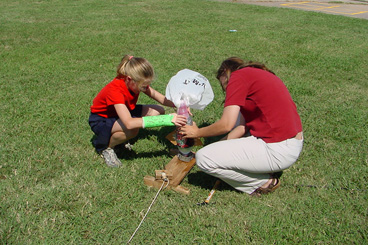 |
Sinsel and student Caitlyn Goodman prepare to launch a small rocket. |
More NASA Projects
In 2005, she was chosen to make another trip to a NASA facility, this one to the Ames Research Center in California. “That was through a program called Space Systems Educators Cohorts,” she said. “We went there for five days to learn about aerospace systems and how Ames is working with those systems.” For example, Ames develops the software that the Dallas-Fort Worth Airport uses for air traffic control. Sinsel learned how NASA and Ames are working with the Air Traffic Control System and the Federal Aviation Administration to make air traffic safer, more convenient, and to “keep more flights on time.”
Her experiences and the contacts she has made with NASA and other officials have helped her teaching, especially on such projects as building a full-size space shuttle simulator for her class. “I probably put 200 hours of research into the design of the simulator itself and the curriculum that I wrote to go along with it,” she said.
Sinsel later built a capsule, similar to that used in the Apollo era, as a model for a system that could eventually to go to Mars.
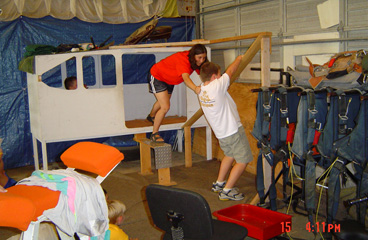 |
Salem Cusick learns how to exit an airplane, using a skydiving trainer. Sinsel is a skydiver. |
“In our math class right now the students are working on the engineering design challenge that NASA has put out,” she said. Her students are “building a plant growth chamber to evaluate some basil seeds that were grown on Barbara Morgan’s flight.” (Morgan, a former teacher, flew on Endeavour in 2007.) NASA made available some 200,000 packets of seeds “and we will build a plant growth chamber. Then, we can compare the growth of the micro-gravity seeds to regular seeds,” she said.
All in all, NASA has “a great education division and they are very helpful to teachers,” she said.
Sinsel still hopes to one day get her students into one of the NASA sessions in which ground personnel talk to astronauts during an actual spaceflight. “Those are really tough sessions to get into,” she said.
Like many teachers, Sinsel is concerned about the overall lack of interest in science among students and, particularly, the shortage of science teachers.
“I think I have had a lot of kids who have shown an inclination to go into science,” she said, but even so, she added, “I’m not sure I have had many” who want to be science teachers.
But, she concluded, “I feel that aerospace is such a motivator for kids, and any topic can be made more interesting if you incorporate aerospace into it.”
Bruce D. Callander is a contributing editor of Air Force Magazine. He served tours of active duty during World War II and the Korean War and was editor of Air Force Times from 1972 to 1986. His most recent article for Air Force Magazine, “First Shirts,” appeared in the January issue.